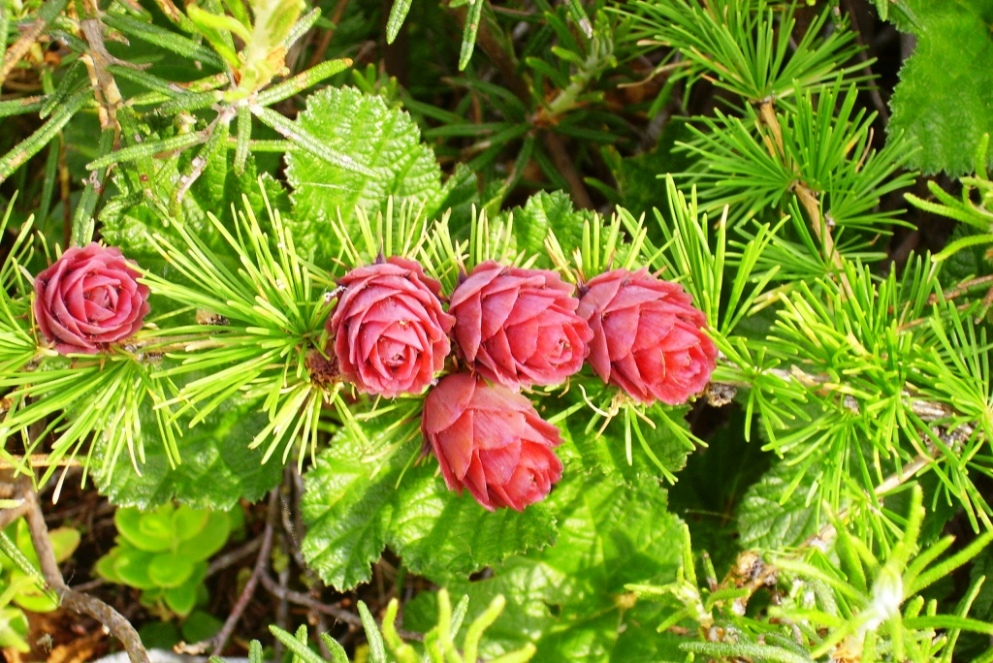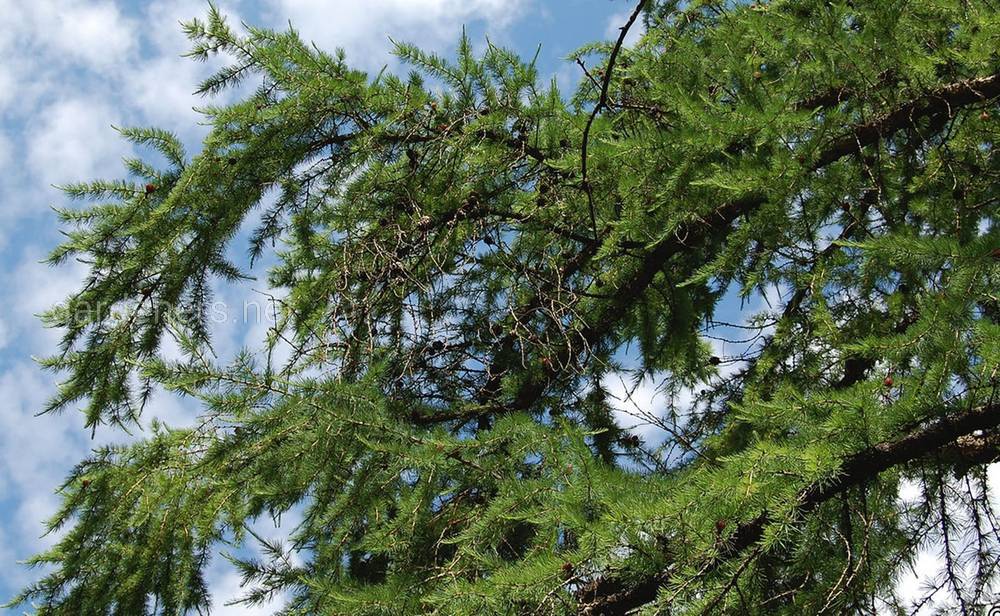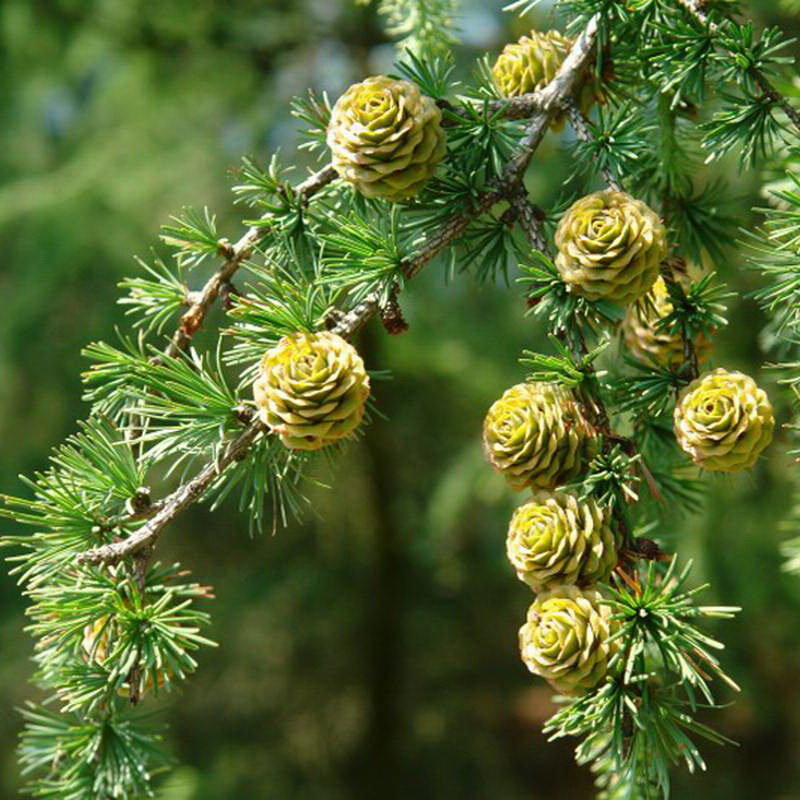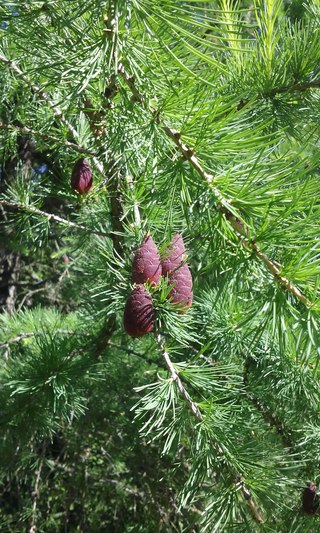Diseases and pests
Like any coniferous plant, Kaempfera is distinguished by a rather high immunity, resistance to diseases and pest attacks. Nevertheless, she still faces some diseases.
- Deciduous moth - more popularly known as "coniferous worms". The needles of a diseased plant become flabby to the touch and more faded. The affected shoots must be removed, if the area of the disease is large, additional treatment with insecticides will have to be performed.
- When attacked by aphids, the needles are deformed and turn yellow. Similar symptoms occur when a culture is damaged by leafworm caterpillars or a deciduous sawfly. Chlorophos or Fozalon is highly effective against these insects.
- With the onset of spring, young needles become food for the larch sheath beetle caterpillars. Treatment with "Rogor" saves from this parasite, the course of treatment must be repeated at the beginning of June.
- To protect the plant from bark beetles, stubble beetles and bark beetles, the land near the bush and larch bole should be treated with Karbofos or Decis solution.




During the rainy season, when the air humidity is increased, the risk of developing fungal infections is high, namely:
- if brown spots appear on the bark - most likely, the plant is affected by the shute fungus; in the absence of emergency measures, the needles quickly turn yellow, dry up and fall off, in the early stages of the disease, a solution of colloidal sulfur or Bordeaux liquid helps;
- root sponge, edged tinder fungus and some other fungi cause trunk rot; copper sulfate is highly effective in this case;
- the greatest danger to a tree is a fungal infection of rust; copper-containing fungicides help to treat it.
How to propagate larch: conditions for growing crops from seeds
The most rational way of reproduction of larch is seed. Only freshly harvested seeds are suitable, but even among them the germination percentage is small. When stored under normal conditions, germination is lost after a year, and sometimes even after 3-4 months, but if they are kept in an airtight container at temperatures from 0 to H-5 ° C, then they will rise in 10 or more years.
Seeds freshly dropped from the cones are capable of immediate germination, since their embryo is in a shallow dormancy stage, but dried and even more so stored seeds need to awaken the embryo with the help of stratification.
The following methods of sowing crop seeds are most rational:
- Winter sowing. In the fall, immediately after harvesting, without drying, the seeds are sown in the ridge to a depth of 3-5 cm and mulched to a height of 1-1.5 cm. In the spring, after germination, the plants are cut open or left on the ridge until autumn or next spring.
- Snowing. Seeds are sown in boxes in autumn or winter, kept warm for 2-3 weeks and then brought out under the snow until spring. In the spring - at the beginning of summer, after the emergence of seedlings, the plants are spread out in the ridge or left in boxes until autumn.
- Cold stratification. At the end of winter, seeds are sown in boxes or bowls in an earthen mixture consisting of rotted leaf earth, peat and coarse sifted sand in a ratio of 3: 1: 1. Crops are kept warm for 2-3 weeks, and then stored in a refrigerator or basement at a temperature of +3 to +5 ° C for 1-2 months, maintaining an even moderate level of substrate moisture and a constant temperature.
Stratified seeds for growing larch are transferred for germination to a light warm (+ 18 ... + 25 ° С) place. Seedlings are protected from direct sunlight and watered moderately. If the seeds have sprouted too thickly, then a pick is necessary.When the heat comes, the crops are taken out into the garden, and after hardening, they are planted in the ridge.
When growing larch seeds from seeds, seedlings are unpretentious and develop quickly.
Creeping forms can be propagated by horizontal branches, but rooting rarely occurs in the first year. Cutting is possible, but it is very difficult and ineffective.
How to plant?
European larch must be planted according to all the rules. First, you should prepare a place for planting and seedlings. Let's consider how to do this.
- The planting pit will need to be prepared no later than 14 days before all procedures. If necessary, completely replace the substrate. It is made from deciduous humus, sand and peat in a ratio of 3: 2: 1. A drainage layer is required - 20 cm.
- Gravel or crushed brick is poured into the pit, then the rest of the volume (about 70%) is filled with the prepared substrate. Then fill with water until it stops absorbing.
- A plant seedling is best purchased in a nursery. In most cases, grafted larch trees are imported; they are bought in special containers.

Then you can proceed to landing. In this case, it is necessary to disturb the roots to a minimum.
It is important to be very careful with larch. Landing is carried out in the following sequence:
- part of the soil from the dug hole is removed using a shovel;
- a seedling is installed in the center;
- fall asleep with a substrate mixture, constantly pressing from the edges of the fossa to the center;
- a mound is made along the edge of the trunk circle so that moisture is retained;
- followed by abundant watering until the water is absorbed;
- when there is no moisture, the soil must be mulched with a layer of 5-7 cm.

The use of larch in landscape design
Larch is highly decorative, therefore it is popular in landscape design. They use it in a variety of ways.
Comment! When planting, remember about the size of the tree and its rapid growth. He needs to leave enough space.
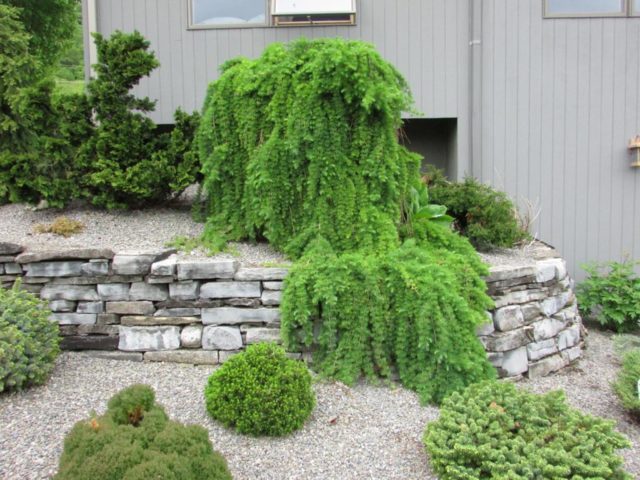
Varieties with a weeping crown look original and spectacular in the landscape
Larches look good even in single planting
One tree will look good on the lawn. You can put a bench or chaise lounge in its shade. You can make the tree the center of the composition. It will look good surrounded by perennials. If they bloom in the fall, then it is better to refuse from the yellow-orange gamut, since it will merge with the needles.

Weeping forms can be used to create living arches, planting near bodies of water
Any species of this genus look good in a rock garden. It is better to plant no more than two trees in them.

Larch can be used to create a composition with other conifers
To create original compositions, you can use unusual stones, small sculptural forms
Care
The soil near the plantings must be kept clean by pulling out weeds. It is required to loosen the soil around the plants to a depth of 7–10 cm. Young seedlings need a lot of moisture, so watering should be frequent and abundant, once a week, 20 liters of water for each trunk. Trees older than 5 years get by with natural rainfall.
Fertilize plantings twice a season. For this purpose, complex mineral compositions, potassium additives, liquid organic solutions, humus, peat are used.
For the winter, larch trees are not insulated. In severe frosts, young shoots can be covered with snow so that the root system does not suffer. Mature trees do not suffer from cold weather.
Crowns are cut for sanitary purposes in the spring, after the snow melts. The emerging haircut is carried out in June. During the season, you can cut up to ⅓ of the length of the shoots, during the growing season they quickly recover.

Red-leaved trees for small summer cottages
red-leaved fan maple, or palm-shaped (Acer palmatum) Fan maple f. atropurpureum, photo
Fan maple f. atropurpureum, photo
... Fan maple 'Beni-Kagami'. Photo from the site forums.botanicalgarden.ubc.
- f. atropurpureum - leaves are deeply lobed, red-purple, in autumn - bright red, as if burning;
- ‘Beni-Kagami’ - 8 m high and wide, weeping, 5-lobed leaves, red-purple;
- ‘Bloodgood’ - 5 m high and 5 m wide, 5-lobed leaves, red-purple, red fruits;
- ‘Burgundy Lace’ - 4 m high, 5 m wide, 5-lobed leaves, dark purple;
 'Bloodgood' fan maple. ... 'Burgundy Lace' fan maple.
'Bloodgood' fan maple. ... 'Burgundy Lace' fan maple.
- ‘Chitoseyama’ - 2 m high, 3 m wide, leaves are 7-lobed, deeply cut, crimson-green, purple-red in autumn);
- ‘Crimson Queen’ - 3 m high, 4 m wide, arched shoots, delicate leaves, finely cut;
 Fan maple 'Chitoseyama'. ... Fan maple 'Crimson Queen'.
Fan maple 'Chitoseyama'. ... Fan maple 'Crimson Queen'.
- ‘Dissectum Atropurpureum’ - leaves red-purple;
- ‘Garnet’ - the leaves are red-purple;
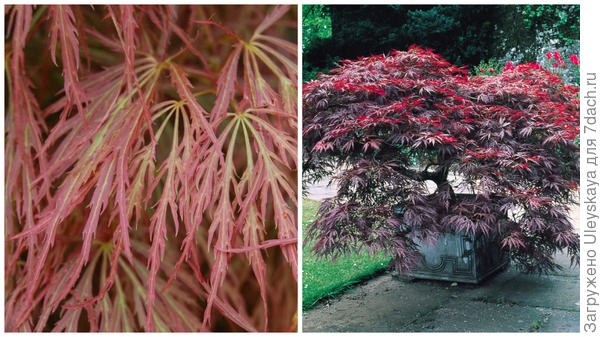 Fan maple 'Dissectum Atropurpureum'. ... 'Garnet' fan maple.
Fan maple 'Dissectum Atropurpureum'. ... 'Garnet' fan maple.
- var. heptalobum ‘Rubrum’ - leaves dark red-purple;
- 'Linearilobum Atropurpureum' - Red-purple shoots.
 Fan maple var. heptalobum 'Rubrum'. Photo from esveld.nl. Fan maple 'Linearilobum Atropurpureum'. Photo from the site sironivivai.it.
Fan maple var. heptalobum 'Rubrum'. Photo from esveld.nl. Fan maple 'Linearilobum Atropurpureum'. Photo from the site sironivivai.it. Red-leaved maple in a Japanese garden,
Red-leaved maple in a Japanese garden,
European beech (Fagus sylvatica)
- f. purpurea - copper leaves (in autumn) - for a large summer cottage;
- ‘Purpurea Pendula’ - 3 m high and wide, weeping crown, dark purple leaves - for a small summer cottage);
 Forest beech f. purpurea. Forest beech 'Purpurea Pendula'.
Forest beech f. purpurea. Forest beech 'Purpurea Pendula'.
- 'Riversii' - dark purple leaves;
- 'Rohanii' - deeply cut, purple leaves.
 Forest beech 'Riversii'. Photo from the site Beech forest 'Rohanii'.
Forest beech 'Riversii'. Photo from the site Beech forest 'Rohanii'.
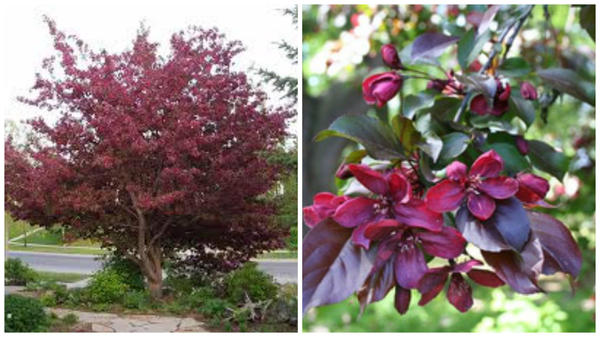 ‘Malus Royalty’ exterior. Photo from the site. Blooming shoot. spread plum (Prunus serasifera) 'Pissardii'
‘Malus Royalty’ exterior. Photo from the site. Blooming shoot. spread plum (Prunus serasifera) 'Pissardii' Cherry-leaved plum 'Pissard', photo
Cherry-leaved plum 'Pissard', photo
silver birch (Betula pendula) 'Purpurea' Hanging birch ‘Purpurea’. Photo from the site. Close-up of her shoots.
Hanging birch ‘Purpurea’. Photo from the site. Close-up of her shoots.
- horse chestnut (Aesculus x neglecta) ‘Erythroblastos’;
- red canadian (Cercis canadensis) 'Forest Pansy';
- oaks (Quercus);
- peach (Prunus persica).
 Red-leaved peach 'Burgundy'. Crimson Canadian 'Forest Pansy'.
Red-leaved peach 'Burgundy'. Crimson Canadian 'Forest Pansy'.
Botanical description
In favorable conditions, it grows up to 50 m in height with a trunk diameter of up to 1 m. It lives up to 300-400 years, larches up to 800 years old have been recorded.
The crowns are loose, translucent by the sun, conical in young trees. With age, they acquire a rounded or ovoid, blunt-topped shape. With constant winds, one-sided-flag-shaped.
The needles are annual, soft. Flattened, bright green, located on elongated shoots spirally and singly, and on shortened ones - in bunches, 20-40 (50) pieces in each. In the fall, the trees completely shed their needles.
Crown shape. Siberian larch in winter
Cones in autumn
Larch is a monoecious plant. Male spikelets are round-ovate, yellowish, 5 to 10 mm long. Stamens with two anthers. Pollen without air sacs. Female buds are reddish pink or green. Pollination occurs simultaneously with the blooming of needles or immediately after blooming, in the south - in April - May, in the north - in June. Cones ripen in autumn in the year of flowering, have an ovoid or oblong-rounded shape with a length of 1.5 to 3.5 cm. Seed scales are hard, longer than coverts. Mature cones open either immediately, or - after overwintering - at the beginning of spring. Seeds are small, ovate, with tightly attached wings. Fruiting begins at about 15 years of age. Abundant seed years are repeated at intervals of 6-7 years. Seed germination is low.
Cones in summer
The root system of larch under normal conditions is powerful, branched, without a pronounced tap root, with strong lateral roots buried at the ends, the presence of which ensures the wind resistance of the tree. Rooting of branches in contact with the soil is sometimes observed. In conditions of waterlogged soils, as well as in shallow permafrost, the root system is superficial. At the same time, the trees suffer from windfall. In the floodplains of rivers, on moss bogs, in conditions of deepening of the root part of the trunk with a growing layer of mosses or being covered with a sandy-silty layer, larch forms adventitious roots.
Larch is an extremely light-loving tree; it does not regenerate or grow in shade. It grows quickly in favorable conditions. Up to the age of 20, it is able to add from 50 to 100 cm per year.
Larch Alley in Tsarskoe Selo
Larch is resistant to spring frosts, very resistant to low winter temperatures, undemanding to the thermal regime of the growing season - that is why it is widespread far beyond the Arctic Circle.
It is also undemanding to the soil. It grows on mossy bogs, waterlogged moors, with close permafrost, on dry skeletal soils of mountain slopes. In such unfavorable conditions, larch is undersized and stunted.Optimal soils that give larch opportunities for the best development are moist and well-drained loams or sandy loam soils of gentle slopes and river valleys.
In places unfavorable for other species - on heavy and waterlogged soils, in permafrost regions, on maria - it forms purely larch plantations. Under better soil, climatic and hydrological conditions, it grows in a mixture with pine, spruce, cedar, fir, birch, and other species. It populates well burned areas and fresh, ungraded clear cuttings. Seedlings and natural undergrowth are hardly damaged by rodents.
Description and varieties of larch
Scientists studying the pine family have long figured out which group of plants the larch belongs to: deciduous or coniferous. Their verdict is towards conifers. It is known that evergreen conifers do not shed their needles for the winter. Among them there are a couple of species that shed needles. For example, swamp cypress, which grows in the Crimea, and larch, which grows all over the world. Many species of these trees have been bred:
- Siberian - unpretentious, but requires bright lighting. Popular with summer residents. The seeds ripen in late autumn.
- Daurskaya - an inhabitant of Kamchatka and the Far East, feels great in the harsh climatic conditions of mountainous areas. Any soil is suitable, even rocky and sandy areas, wetlands, tolerates shallow permafrost.
- European (Larix decidua) - the length of the central trunk is twenty-five meters. The bark is thin, scaly. Cones are brownish, oblong, scaly, dense, difficult to open.
- Polish - a hybrid of Siberian and European (Larix decidua and L. sibirica). It grows in the Polish Carpathians, neighbors with Scots pine, beech, oak, white fir. Deciduous tree up to thirty meters tall with a regular conical crown, annual growth up to 30 centimeters. Undemanding to the soil.
- American Hartwig Pine is a low-growing variety in the form of a shrub, with an annual growth of five centimeters, has a crown in the form of a ball of blue-green color, becomes golden yellow by autumn, the cones are small. Loves an open, sunny area. In severe frosts, it needs shelter.
- Japanese, or Kempfera - grows in mountainous areas. Loves the sunny slope of the mountains and dry clay soil. A colorful plant with a bright spot stands out against the background of greenery with a bluish shade of needles, suitable for growing in the yard. Beautiful yellowish cones in the shape of a ball with a diameter of three centimeters.
- Prince Ruprecht is the most winter-hardy plant, undemanding to the soil, it grows even on stony salt marshes. Does not tolerate spring floods. In spring it pleases the eye with bright green needles, in autumn - orange-yellow. Looks good in collaboration with other types of conifers, emphasizing the range of spring and autumn colors.
- Olginskaya - chose the mountain slopes of the seaside, grows in friendship with birch, oak, linden. Under favorable conditions, it takes the form of a slender tall tree. Young twigs are very beautiful, pink or reddish brown in color. Coniferous leaves are narrow and thin, up to three centimeters long, gray below. The cones look like a small egg two centimeters long with protruding scales.
Pear variety Chizhovskaya: the secrets of planting and care
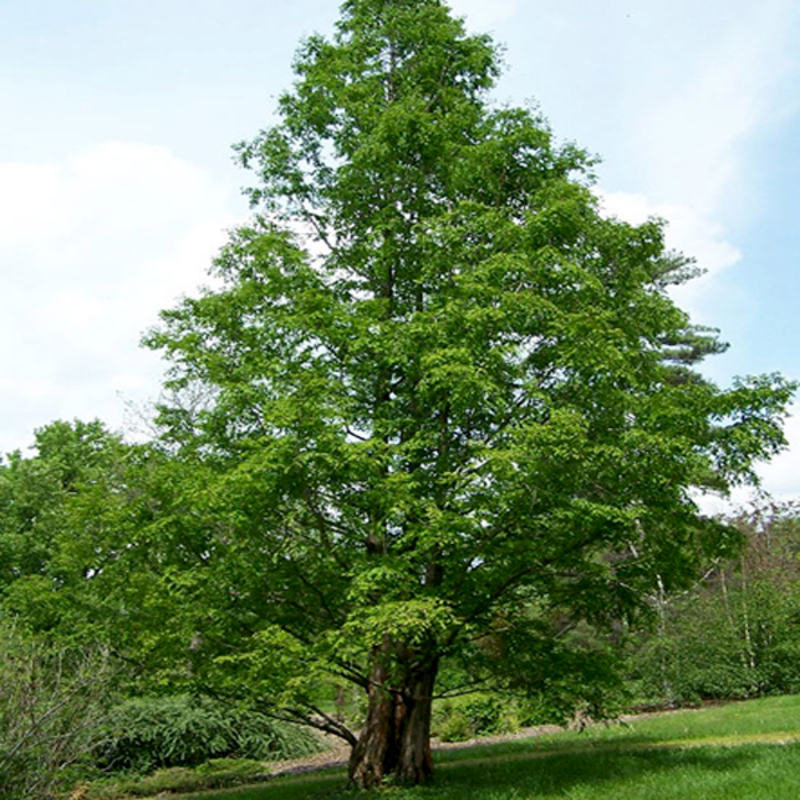
Of all the species, the representative of Western Siberia, the inhabitant of the taiga - Larix sibirica Ledeb and the European larch have proven themselves best of all. From the name it is clear that European grows throughout Europe.
 European larch is a very large plant. Some specimens grow up to 50 meters in height, and the crown width is about 15 meters. Naturally, a lot of space is needed for planting in the garden. In order to restrain the growth of this tree, a simple method is used - pruning. The tips of the branches and the main central trunk are trimmed.Despite the fact that larch grows very quickly, many hobbyists want to plant a large tree.
European larch is a very large plant. Some specimens grow up to 50 meters in height, and the crown width is about 15 meters. Naturally, a lot of space is needed for planting in the garden. In order to restrain the growth of this tree, a simple method is used - pruning. The tips of the branches and the main central trunk are trimmed.Despite the fact that larch grows very quickly, many hobbyists want to plant a large tree.
For such purposes, various low-growing varieties have been bred, for example, weeping larch. This plant does not need careful care, a minimum of attention is enough: plant in a dry, sunny area. For feeding, a little complex fertilizers with microelements. The main procedure for tree care is pruning.
Pendula is especially popular with conifers. This gorgeous tree has a decorative shape in the form of a ball with a jet arrangement of branches that do not stretch up, but slightly down. The green waterfall is bright green in summer, bright yellow in autumn. Before frost, she sheds her leaves - needles. You can get such a copy only by vaccination. She does not require special care.
Care
To grow a healthy and beautiful tree, it is important to care for it as it develops. Let's consider the main steps
Watering
Drought is harmful for ornamental larch. Young trees need to be watered once a week (2 times in summer). Each watering should have 15-20 liters of clean water. For representatives of the culture over 5 years of age, moisture obtained from the natural environment is sufficient.
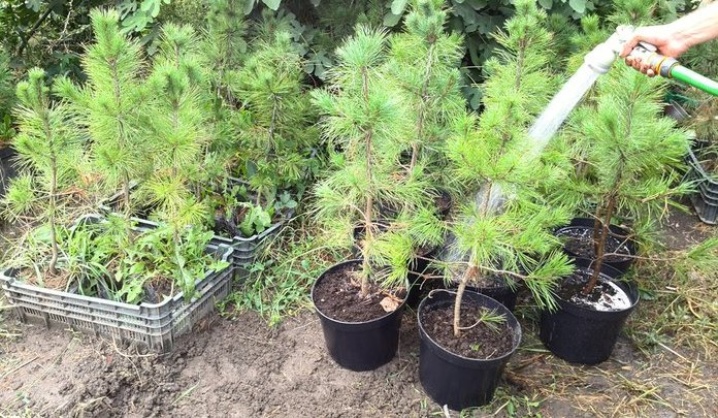
Pruning
Culture is not suitable for creating decorative figures, however, the formation of a neat-shaped crown is quite possible. In the spring, large branches are pruned for sanitary purposes. To enhance the splendor, you need to cut off young shoots. This is done after the end of the period of active growth, but before the onset of lignification. Decorative pruning helps to shape the plant into a regular pyramid or ball. And also this procedure allows you to control the height of the tree. Forming procedures are carried out in June.

Fertilizer
Fertilization of the culture is carried out twice a season. For this, complex mineral compositions are used. Preparations must necessarily contain potassium and magnesium. To support the shoots, "Kemira" is brought in in the spring. Enough 100-130 g per square meter.

Weeding and loosening
The soil near the plantings must always remain clean. Weeds must be removed. Loosening is carried out at a depth of about 10 cm.

Views
There are about 20 species of larch in nature. As a result of interspecific pollination, many of them form hybrid forms. Common tree varieties:
- Siberian. It grows in the Northern Urals, Siberia, Sayan Mountains, Altai, grows in mixed forests in flat areas and in the mountains up to 2900 meters above sea level. Often inhabits old burnt places, wastelands. The height of the trees is up to 35–40 m. The crowns are openwork, pyramidal. The young bark is light brown, smooth, with age it becomes brown, it can peel off with plates. The Siberian species is cold-resistant, prefers sod or podzolic soils, and loves moisture. Can exist in urban environments.
- Western. Grows in Canada, in the northeastern United States, rises to 2500 meters above sea level. The tallest species. The length of the trunks is up to 80 m. The crowns are narrow, pyramidal. The needles are soft, bright green, needles about 3 cm long.Cones are oblong, light brown, up to 5 cm long.
- Japanese or fine-scaled. Far Eastern species growing on the Japanese islands, Sakhalin, Kuril Islands. Trees reach a height of 28-30 m. The crowns are cone-shaped, openwork. The needles are bluish-green, needles up to 5 cm long, spirally arranged. The bark is reddish or reddish, lighter than other species. This larch prefers fertile soils, grows slowly, stretching by 20 cm per year.
- European. Distributed in the Alps, the forests of the Carpathians, Western Europe. Trees reach a height of 30–40 m. The crowns have a wide pyramidal or irregular shape. The needles are gray-green. The bark is brownish-gray, fractured. The species is drought-resistant, does not tolerate waterlogging, develops on any soil. Life expectancy is up to 400 years or more.
- Daurskaya. The second name is Gmelin larch. Distributed in the regions of Eastern Siberia.Trees grow up to 35 m in height, the crowns have a pyramidal shape, in open windy areas they become irregular, one-sided. The needles are bright green, 2-3 cm long. Cones are light green. The most cold-resistant and hardy species. It develops on marshy soils, in the mountains, and tolerates drought well.
- Primorskaya. Hybrid variety. It grows in the Far East: in some areas of the Primorsky Territory, on Sakhalin. Trees up to 25 m high. Needles of a bluish hue. The crowns are narrow pyramidal. Cones up to 5 cm long.
All varieties of larch shed their needles every year. In September or October, it turns yellow, flies around. In May, the shoots are covered with new needles.
Classification
Larch grove near the village of Gaiter.
Taxonomy edit code
View Gmelin larch belongs to the genus Larch (Larix) of the Pine family (Pinaceae) of the order Pine (Pinales).
| 6 more families | 11 more species | ||||||
| order Pine | genus Larch | ||||||
| Department Conifers | family Pine | view Gmelin larch | |||||
| three more extinct orders | 10 more births | ||||||
Varieties edit code
Within the framework of the species, several varieties are distinguished:
Larix gmelinii var. gmelinii - grows in most of the species range, from the Yenisei to Kamchatka
Larix gmelinii var. japonica (Maxim.ex Regel) Pilg. - grows on Sakhalin and the Kuril Islands
Larix gmelinii var. olgensis (A. Henry) Ostenf. & Syrach - grows in Primorye, in the north of the Korean Peninsula and in the Chinese provinces of Jirin and Liaoning
Larix gmelinii var. principis-rupprechtii (Mayr) Pilg. - grows in the Chinese provinces of Hebei, Henan and Shanxi;
How to plant?
There is an option of growing a kaempfer from seeds, but this is a very troublesome and long-term business, so it is best to buy a seedling in a nursery.
When buying, you should pay special attention to the quality of the planting material. If the plant is strong, has a full-fledged, formed root system, a healthy, elastic trunk and bright needles - the seedling can be used for further breeding.
If the needles have acquired a yellowish tint, most likely, this plant is sick, and it makes no sense to plant it. For planting on a permanent site, 1-2-year-old crops are suitable.

The roots of Japanese larch are deep and branched, due to which the plant is particularly wind-resistant. Planting work is not difficult. The depth of the planting hole is approximately 1 m, the width should be 2-3 times the diameter of the root system. The bottom must certainly be laid out with expanded clay, pebbles or any other drainage with a layer of 10-15 cm.
For planting, a soil mixture is prepared, consisting of sod land, as well as peat and river sand, taken in a ratio of 3: 2: 1. Half of the soil substrate is poured directly onto the drainage, then a seedling is placed and covered with the rest of the substrate.
Diseases
In the natural environment, Daurian larch is sick less often than when grown on a personal plot. The main reason is improper care, non-compliance with the planting scheme and the proximity of unacceptable plants.
Rust
Signs of the development of the disease are the appearance of yellowish or reddish swellings on the trunk and shoots. Over time, the areas affected by the fungus die off and die.
Trees can be cured if damaged organs are removed, treated with a solution of copper sulfate, and fed with a mineral complex composition with the addition of immunostimulants. To avoid infection, ephedra should not be planted next to a birch tree.
Alternaria
With this sore, the branches are covered with a black bloom, the needles are massively crumbled. Affected young specimens are not able to survive the winter and die.
To avoid infection, it is necessary to avoid thickening, regularly carry out a sanitary haircut and cut out all the branches that thicken the crown.
Schütte
The peak of the development of the disease occurs at the end of spring - in plants infected with the fungus, numerous reddish spots can be seen on the surface of the trunk and skeletal branches. As a result, the needles begin to turn yellow and crumble en masse. First of all, the infection damages the apex, then spreads throughout the crown.
At an advanced stage, it is almost impossible to cure larch, therefore it is disposed of.
In order to avoid infection, it is necessary to follow all the rules of agricultural cultivation, to remove and process the affected parts on the tree in time.
Rot and staggered cancer

The infected tree may die
Plants with damaged bark from sunburn or frost are most susceptible. In the wounds and cracks, pathogenic bacteria and fungi appear, which provoke the development of cancer and various types of rot.
Both young and adult trees can hurt. The affected organs die off. At an advanced stage, treatment is useless.
For prevention, it is necessary to treat the damaged bark with a solution of copper sulfate or Bordeaux liquid, and cover it with garden pitch.
Types and varieties
There are about 20 different species of larch, among which there are also different varieties. Interspecific pollination is also responsible for the appearance of hybrid forms (for example, seaside larch). Let's consider the most common varieties.
Siberian
This larch is often called common. You can meet her in the Urals, in Siberia. This species prefers coniferous forests with humid air, sod or podzolic soils. Often spawns in the wastelands. Trees grow up to 40 m. The crowns are openwork, at first they have the shape of a pyramid, then they are rounded. Young specimens have smooth, pale brown bark. With age, it darkens, acquires a lamellar appearance. The foliage is light green.

European
This species is native to Western and Central Europe. Such larch does not like swamps. It grows well on other soils. She especially likes loamy soil with moderate moisture. Found in mixed forests.
The crown can have the form of a cone, although it can also be of an irregular shape. The needles are moderately green, the bark is grayish-brown. This variety grows quite quickly. The maximum height is 50 m. Among the varieties can be distinguished Kellerman's dwarf bushy larch, the weeping variety of Pendula, the original Repens with branches hanging down to the ground, similar to the Little Bogle scarecrow, Horstmann Rekurved with a curved shape.

Western (American)
As the name implies, this species is native to the United States and Canada. This is the tallest variety (it can reach 80 m). The crowns are narrow, pyramid-shaped. The bark is brown with a gray tint. The needles are light green, fall off in October. The buds are egg-shaped and light brown in color. This species prefers mixed forests, well-drained moist soils.

Japanese
You can meet this variety in Japan, as well as on Sakhalin, where there are fertile soils. Trees grow up to 30-35 m. The crowns are wide, openwork, pyramidal. The needles are bluish-green. The needles are arranged in a spiral. The bark is scaly, reddish-brown. The decorativeness of the tree is very high. Among the most popular varieties are Stiff Viper, Blue Rabit, Diana.
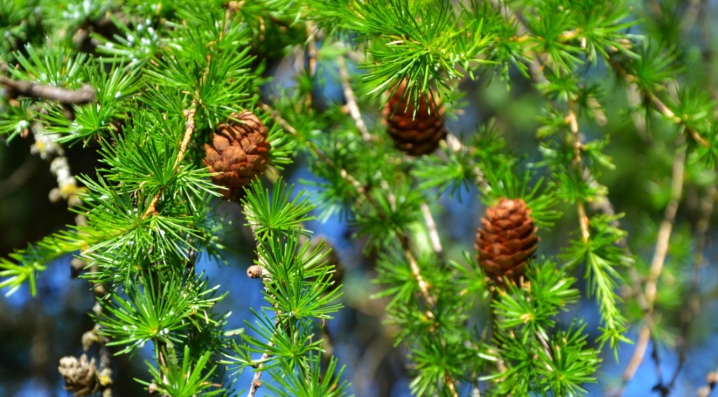
Daurskaya (Gmelin)
This variety can be seen in the east of Siberia. The maximum height is 30-35 m. In the Far North, the trees are quite low. The crowns are in the shape of a pyramid. If the crop grows in an open, windy area, it can take on an irregular, one-sided shape. The bark is reddish, thick. The needles have a rich green color. Cones are oval. The view is very unpretentious. Easily tolerates both low temperatures and drought.

Cajandera
This variety of larch is common in the Okhotsk Sea region. Some people recognize this type as a variation of the previous one with minor differences. The tree is not too large, in favorable conditions it grows up to 25 m. The bark is brown, the cones are round in shape.

Sukacheva
This species grows in the north-east of Russia. The height can reach 45 m. The needles grow in bunches. The buds gradually change color from pinkish to brown. The shape is spherical. This variety is undemanding to the soil. It is found in both coniferous and mixed forests.
Some varieties of larch were named according to the place of distribution (for example, Angarsk, Arkhangelsk), but this is an unofficial classification. As a rule, such trees belong to one of the recognized biological groups.



